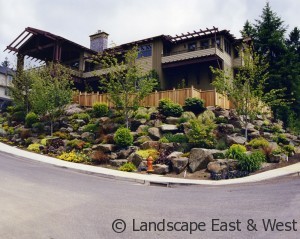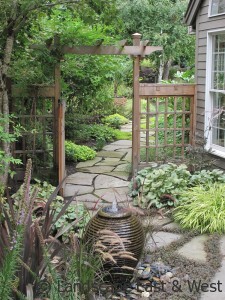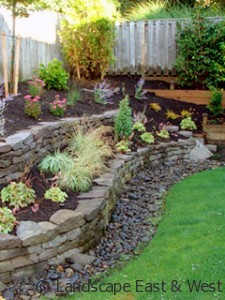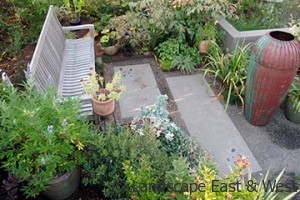3 Key Principles to Expert Portland Landscaping Design
 The Dalai Lama riffed on a popular adage when he advised, “Know the rules well, so you can break them effectively.” As any Portland or Beaverton landscaper will tell you, this principle definitely applies to landscape design. If you begin with sound design rules as your foundation, it will be easy to create a beautiful, universally appealing garden – even if you decide to break a few of those rules in favor of your own creative preferences. Below, we name three basic design doctrines that can help you design your ideal outdoor space.
The Dalai Lama riffed on a popular adage when he advised, “Know the rules well, so you can break them effectively.” As any Portland or Beaverton landscaper will tell you, this principle definitely applies to landscape design. If you begin with sound design rules as your foundation, it will be easy to create a beautiful, universally appealing garden – even if you decide to break a few of those rules in favor of your own creative preferences. Below, we name three basic design doctrines that can help you design your ideal outdoor space.
Looking for help with your Portland landscaping design? Our award-winning design experts are on hand to help you every step of the way. Visit our Design/Build page for information on patios, retaining walls, outdoor kitchens and more.
Landscape Design Principle #1: Unity
 Unity helps everything in your garden “hang together.” There are a couple of ways to achieve unity and thereby avoid landscape chaos:
Unity helps everything in your garden “hang together.” There are a couple of ways to achieve unity and thereby avoid landscape chaos:
Repetition. You can repeat almost anything in the garden to create a sense of consistency. For instance, landscape designers often create unity by planting the same species in different parts of a property. The human eye delights in recognizing the same plant in different locations.
Consistency. Think about creating a consistent color palette. Size can also be a means of creating consistency, as can texture.
Both repetition and consistency are easy to create when you choose a theme for your landscape. For instance, if you’re fascinated with hummingbirds, you could theme your garden around them. A Beaverton landscaper might recommend that your main color should be magnetic red, as showcased in hollyhocks, red columbine and fuchsia. Hummingbirds adore red blossoms. Furthermore, you could add hummingbird accessories such as feeders.
Landscape Design Principle #2: Proportion
 Landscape designers speculate that this is the most commonly disregarded rule in landscape design. Proportion refers to the practice of appropriately sizing different landscape elements. Basically, you want the size of garden statues, seating and species to match the size of your property. If you’ve ever seen a garden that just didn’t look right, chances are poor proportions were to blame.
Landscape designers speculate that this is the most commonly disregarded rule in landscape design. Proportion refers to the practice of appropriately sizing different landscape elements. Basically, you want the size of garden statues, seating and species to match the size of your property. If you’ve ever seen a garden that just didn’t look right, chances are poor proportions were to blame.
For instance, if you have a small backyard space, a gigantic topiary probably won’t work; it will seem ridiculously large. However, a beautiful outdoor bonsai plant would match your miniature space and meet the landscape design rule of proper proportion.
Landscape Design Principle #3: Simplicity
That old American song says it’s a gift to be simple, and landscape designers couldn’t agree more. Don’t let your landscape design get too chaotic. For instance, rather than selecting ten different shades for your garden, choose two or three complementary colors. Keeping things simple will help your landscape’s most striking elements shine.
Designers across the globe are united in certain principles. From interior designers to artists to landscape designers, certain ideas ring true across applications. You can apply the universal design principles listed below to create a more sophisticated, appealing landscape design.
Achieve Unity through Consistency and Repetition
 The human eye delights in familiarity. If you echo similar textures, colors, plant types and vertical heights throughout your landscape design, guests and family members will be more attracted to your garden.
The human eye delights in familiarity. If you echo similar textures, colors, plant types and vertical heights throughout your landscape design, guests and family members will be more attracted to your garden.
Landscape designers recommend using a theme to tie everything together in your landscape design. For instance, if you love fluttering winged insects, you might choose to create a butterfly garden, with all the flowers that butterflies adore – e.g. liatris, phlox, bee balm, purple cone flowers, etc. Other possible themes include: soothing Zen, traditional English garden, or tropical. Choose a theme that resonates with your own tastes and interests. Once you have a theme in mind, it’s easier to find accessories, plants and other elements that will bring unity to your landscape design.
Keep it Simple
As American aeronautical engineer Clarence “Kelly” Johnson said, “Keep it simple, stupid!” Now, we don’t mean to imply that you’re unintelligent. Rather, like Mr. Johnson, we landscape designers simply hope to remind you that good design is usually simple. If you try to accomplish too much at once, you’ll probably create a cluttered, distracting space. Remember, you can always add more later. Avoid creating a crazy-quilt landscape.
One way to keep it simple is to choose two or three colors to repeat across your landscape. Another approach is to use the same materials throughout your landscape design. For instance, hardscaping elements such as pavers and rock borders are a simple way to delineate different areas of your garden.
Focus on Transitions
 Avoid abrupt shifts in your landscape design. Instead, landscape designers recommend gradually shifting the feel of the space using plant size, foliage textures, and colors, among other elements. For instance, when moving from the more public front yard area to a serene backyard oasis, you could establish a strong transition by first featuring bright reds and yellows and then shifting to calming purples and blues closer to the backyard area.
Avoid abrupt shifts in your landscape design. Instead, landscape designers recommend gradually shifting the feel of the space using plant size, foliage textures, and colors, among other elements. For instance, when moving from the more public front yard area to a serene backyard oasis, you could establish a strong transition by first featuring bright reds and yellows and then shifting to calming purples and blues closer to the backyard area.
Line Shape
If you hope to calm viewers, choose curvy lines. Sharp, straight lines, in contrast, are great for moving visitors quickly from one space to another. Straight lines are also excellent in more formal landscape designs.
Proportion
Poor proportion is jarring. A strong landscape design features proportionally sized plants and accessories. For instance, a seven-foot-tall reproduction of Michelangelo’s David statue would definitely feel out of place in a small courtyard garden. Such large, bold statuary would be better suited to a broad expanse. Aim to match the size of your species and ornamentation to the available space in your landscape.
Symmetry and Asymmetry
 You probably have some appreciation for how symmetry can add delight to any landscape design. Repeating similar plants on either side of a walkway is an example of how landscape designers might use symmetry. But asymmetry can also be an effective landscape design method. For instance, you might choose to feature shade plants on one side of your front yard, and sun-loving varieties on the other side. Asymmetry is more difficult to apply in a masterful way, so it may be best to contract with professional landscape designers to achieve it in your space.
You probably have some appreciation for how symmetry can add delight to any landscape design. Repeating similar plants on either side of a walkway is an example of how landscape designers might use symmetry. But asymmetry can also be an effective landscape design method. For instance, you might choose to feature shade plants on one side of your front yard, and sun-loving varieties on the other side. Asymmetry is more difficult to apply in a masterful way, so it may be best to contract with professional landscape designers to achieve it in your space.
Looking for inspiration? You can view our portfolio for some examples of our latest work! Landscape East & West proudly serves the Portland-metro area, including Hillsboro, Clackamas, West Linn, Beaverton and other areas. Get in touch today for your free estimate!
